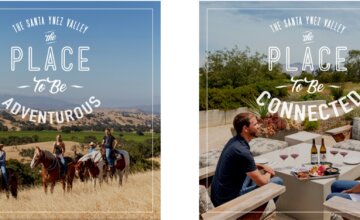DMO Insights – June 22
- Jun 22, 2020
- By Justin Yax
- In DESTINATION, DMO INSIGHTS
I got a COVID-19 test this morning. Not because I have any symptoms or have been in close contact with anyone who has a confirmed or presumptive positive test result. And not because I thought I could be an asymptomatic carrier. My family has been about as diligent as you can be with regard to practicing self-care. We still haven’t been to a restaurant, we wear face coverings in public, and as my son likes to say, we do our best to “keep our distance so we don’t get the allergy.”
Rather, I got the test because my mother, who is a 72-year-old lung cancer survivor, is coming to visit this week and I wanted to provide her with some additional peace of mind due to her elevated risk factor.
The test itself was surprisingly simple and minimally invasive. I pulled into the urgent care parking lot at 8 a.m. and was back home an hour later. After answering a few questions over the phone from my car, a nurse came out to ask a few more questions and take a nasal swab. A few minutes later, a doctor came out to listen to my heart and lungs, and in 48 hours I should have the results in my inbox. The whole visit took about 30 minutes from start to finish. All in all a very small inconvenience for some important peace of mind ahead of mom’s upcoming visit.
In this edition:
- Face coverings work. So why do they divide us?
- BLM + BIPOC + LGBTQ+ = You Are Welcome Here
- Latest research findings from Destination Analysts
- Road Trip! As RV sales surge, are you prepared?
- Signs the virus that causes COVID-19 may be weakening
- Recent news, useful links & upcoming webinars
FACE COVERINGS WORK. SO WHY DO THEY DIVIDE US?
Science tells us that face coverings work. According to a recent study, the “Best way to reduce coronavirus transmission is by wearing a face mask.” In California, Gov. Newsom recently mandated the use of face coverings in public, and in a letter to Arizona’s governor, nearly 1,000 members of the state’s medical community recently implored the governor to mandate face coverings in public as cases and hospitalizations surge there.
So why do so many people refuse or choose not to wear them, and what can (and should) DMOs be doing to help encourage their use among visitors and residents alike? Is it possible that in fact we generally agree on some very common and controversial topics (i.e. face coverings reduce COVID-19 transmission), and are really only divided on the surface?
To answer these questions, I simply asked my wife, who holds a Ph.D. in Social Psychology from the University of Houston and manages the e-Campus Psychology Program at Oregon State University. She quickly pointed out a number of factors – any or all of which may be at play – including defiance, conformity, arrogance, stigma, ignorance, access, entitlement, and even pandemic fatigue. But at the heart of the matter, she suggested a likely culprit: Cognitive Dissonance.
According to Psychology Today, the theory of cognitive dissonance proposes that people are averse to inconsistencies within their own minds. It offers one explanation for why people sometimes make an effort to adjust their thinking when their own thoughts, words, or behaviors seem to clash with each other.
When someone does not wear a face covering in public (behavior), yet they know that an uncovered face increases their risk of COVID-19 infection or transmission (thought), they are in a state of cognitive dissonance. The individual has two choices: change the behavior or modify the belief. Changing the behavior simply means starting to wear a face covering in public. Modifying the belief means rationalizing the behavior by minimizing or discrediting scientific findings, citing the small risk of infection, or defending their personal rights. Smoking and speeding are two good examples of cognitive dissonance. Both increase your chances of injury or death from the behavior, yet many people still choose to do them and find ways to rationalize the behaviors as a means of resolving their own dissonance.
There are several reasons why this week’s Destination Analysts survey findings show an increasing number of Americans (56.8%) are uncomfortable with visitors coming to their destination, and the use (or lack thereof) of face coverings is one of them. So how do we, as DMOs and marketers, help?
While the decision to change behavior is ultimately up to the individual, we can and should be taking steps to minimize the obstacles and barriers that stand in the way of doing so. Some of the tactics DMOs can implement include:
Educate locals and visitors: Travelers are less likely to visit a destination where they perceive safety and compliance to be marginalized. Locals are less likely to encourage or support visitors to their community if they feel like proper protocols and safety measures are not in place. The education of both audiences is critical not only to the resumption of travel, but to making sure that both sides of the picture are comfortable with it. Share and disseminate information and literature.
Normalize the behavior: Depicting people (both visitors and locals) wearing face coverings is the easiest way to help. This can be done through imagery on the DMO website (Leavenworth, Wash. is a good example), organic social media posts and stories, digital advertising, and email communication with stakeholders and consumers.
Reduce the stigma: Look for opportunities to make simple but meaningful changes. The semantics of referring to face coverings, which is a more encompassing and less stigmatized term than masks, can make a big difference. Likewise, city, county, or even statewide mandates can remove the stigma by making the use of face coverings a requirement as opposed to a choice.
Lead by example: This may go without saying, but as destination marketers and leaders it is imperative that we set a good example for others to follow by practicing what we preach.
BLM + BIPOC + LGBTQ+ = YOU ARE WELCOME HERE
Countless statues of controversial figures are being toppled nationwide. Brands like Aunt Jemima, Uncle Ben’s, and Eskimo Pie are pivoting or disappearing altogether. And just yesterday, a noose was found hanging in the pit garage of black NASCAR driver Bubba Wallace. In short, we have seen the good, the bad, and unfortunately the ugly from individuals and society over the past few weeks. While the long-term changes still remain to be seen, if there is a silver lining to come from recent events it is that awareness is high, conversations are happening, and changes are already taking place.
So what happens when Black Lives Matter, the BIPOC movement, and Pride Month all converge, and are all making headlines at the same time? One answer, and one that DMOs have the ability to incorporate into their existing inclusivity messaging, is the You Are Welcome Here campaign recently launched by Out Central Oregon in Bend.
This symbol is one version of the Pride flag, called the “Progress” Pride Flag, and it includes specific colors that represent the transgender community (pink & blue) and the BIPOC (Black, Indigenous, and People of Color) community.
This local unity campaign, which speaks to business owners and consumers, residents and visitors, is another way for destinations to position themselves as being inclusive to people of color, transgender people, and LGBTQ+ people. It lets all people instantly know they are welcome as your guests and patrons. Not only is this valuable for LGBTQ+ and BIPOC tourists, it also tells residents where they can choose to shop and do business.
From a local business and tourism perspective, You Are Welcome Here is centered around three pillars:
- Welcoming BIPOC and LGBTQ+ people
- Celebrating diversity
- Creating positive change
This is one step that can be taken to promote your business and also to promote safety, inclusion, and solidarity with people of color and LGBTQ+ customers. More than 120 businesses including Visit Bend have already “applied” for the program, and walking around downtown on Sunday afternoon I couldn’t help but notice the prevalence of Your Are Welcome Here stickers at local businesses.
DESTINATION ANALYSTS’ WEEKLY SURVEY
Americans’ concern about personally or friends/family contracting COVID-19 increased this week. Now half of American travelers feel the coronavirus situation will get worse in the US in the next month and less than 20% feel it will get better. Americans’ perceived safety of various travel activities also worsened this week, returning to the levels they were at 3 weeks ago, and this has caused some to reverse their travel readiness. As seen in this week’s findings from Destination Analysts, we still have a long way to go to get over the hump.
Optimism gap (still) growing: The gap between the number of American travelers who believe the COVID-19 situation in the U.S. will get “better” or “much better” over the next month, and the number of those who think it will get “worse” or “much worse,” continues to grow. And not in a good way. This week, 50.6% say it will get “worse” or “much worse,” while just 19.8% think it will get “better” or “much better.”
The reality of want vs. need: When it comes to the gap between activities that are important to our lifestyle, and those activities we have recently done, no gap is wider than leisure travel. 58.5% of American travelers say leisure travel is important to their lifestyle, with only 12.1% having recently done so. By contrast (and not surprisingly), Americans are spending more time on activities that are of lower importance to them as a whole, such as social media, binge-watching TV shows, reading, and gardening.
Openness to visitors: After reaching a nine-week low last week, the percent of American travelers who say they do not want visitors coming to their own community right now returned to 56.8 percent. Observing unsafe behavior by their fellow residents appears to contribute to this sentiment. Trust in people to behave safely should increase comfort in travel and tourism overall.
ROAD TRIP! AS RV SALES SURGE, ARE YOU PREPARED?
As Americans return to travel, road trips are replacing air travel as the transportation method of choice for many this summer. With more people expected to choose the comfort, safety, and predictability of their own transportation for the time being, USA Today recently reported that “RV vacations could see boom as coronavirus camping restrictions lift.”
Increased interest in RVs as a method of travel, coupled with many manufacturing facilities closing for extended periods of time during stay at home orders, has created a demand unseen in the industry in years. And with 46 million Americans planning to take an RV trip in the next 12 months, many of them this summer and fall, destinations should be prepared for an influx of Airstreams, Winnebagos, R-Pods, and more.
With that in mind, right now is the time to make sure your destination has the capacity to meet demand without over-taxing existing infrastructure and services, damaging the environment, or disrupting local residents. A few things to consider include:
- Dedicated parking/camping overflow space to minimize overcrowding at dedicated campgrounds, destruction of sensitive environmental areas, or parking on city streets
- Additional RV related services, particularly waste disposal
- Maps, literature, and instructions (online and offline) for RV travelers, many of whom may not be used to traveling by RV
National Geographic Traveler recently published a “What to know about traveling by RV this summer” guide for both first timers as well as for seasoned travelers who are unfamiliar with RVing in a COVID-19 world. This guide is one of many resources available through the media, the RV Industry Association, and Go RVing. When it comes to planning and preparing for increased RV travelers this summer and fall, it’s better to be prepared and not need it, than to need it and not be prepared.
SIGNS THE VIRUS THAT CAUSES COVID-19 MAY BE WEAKENING
As first reported in The Sunday Telegraph (UK), there are signs that coronavirus is weakening and could disappear on its own, even without a vaccine. According to Italian infectious diseases specialist Dr. Matteo Bassetti, the virus appears to have become less potent, perhaps due to genetic mutations. Effective social distancing measures, combined with a lower “viral load” on humans as a result of global efforts to contain the virus, may be contributing to its downgrade from an “aggressive tiger” to a “wild cat.” Dr. Bassetti cites the fact that “even elderly patients, aged 80 or 90, are now sitting up in bed and they are breathing without help. The same patients would have died in two or three days before.” While it’s unlikely that coronavirus will disappear on its own anytime soon, it’s possible, according to Dr. Bassetti and others, that it will be eradicated before researchers find a vaccine.
USEFUL NEWS, LINKS, WEBINARS & MORE
Recent News
How to plan a summer ‘Safecation’ – Today.com – June 19
Yes, wearing masks helps. Here’s why. – NPR – June 21
11 ways the pandemic will change travel – Washington Post – June 15
Iceland now feels like the coronavirus never happened – CNN – June 19
Business travel won’t be taking off soon amid coronavirus – Wall Street Journal – June 15
Useful Links
You Are Welcome Here – Out Central Oregon
Key Survey Findings – Week of June 22 – Destination Analysts – June 22
AirDNA Covid-19 Data Center – AirDNA – ongoing
Guidance for promoting the health & safety of all travelers – U.S. Travel
Upcoming Webinars
Maximizing the utility of geo-location data – Destination Analysts – June 23, 8 a.m. PDT
Coronavirus Travel Sentiment Findings – Week 15 – Destination Analysts – June 23, 8 a.m. PDT
5 local campaigns from DMOs starting to re-open – CrowdRiff – June 25, 12 p.m. PDT



